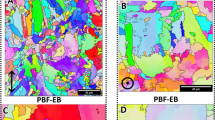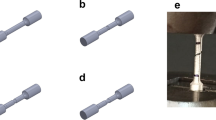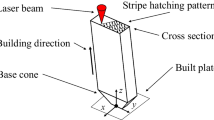Abstract
This study carries out an experimental characterization of lattice structures that are based on cubic cells fabricated through selective laser melting (SLM) and electron beam melting (EBM). The lattice failure under compressive load is studied as a function of the process typology, material properties, and dimensional parameters of the unit cell. The bulk material is first characterized to evaluate the process stability. Three main failure modes of the lattice are identified, depending on the response of ductile/brittle material and the direction of crack propagation. The relationship between lattice geometrical parameters and mechanical strength is observed. The results of the modeling and experiments are suitable to validate the design of lightweight components built with AM processes. The structural performances related to geometrical features, material properties and technological constraints are well explained for further applications in structural design. The equivalent Young’s module of lattice samples with different cell size has been measured and compared with numerical simulations based on the homogenization method.









Similar content being viewed by others
References
Brennan-Craddock J, Brackett D, Wildman R, Hague R (2012) The design of impact absorbing structures for additive manufacture. J Phys Conf Ser 382:012042
Eshraghi S, Das S (2012) Micromechanical finite-element modeling and experimental characterization of the compressive mechanical properties of polycaprolactone-hydroxyapatite composite scaffold prepared by selective laser sintering for bone tissue engineering. Acta Biomater 8:3138–3143
Prager W (1974) Introduction to structural optimization. Springer Verlag, Vienna
Rozvany GI (1997). Aims, scope, basic concept and methods of topology optimization, in: Topology optimization in structural mechanics, Springer
Bakhvalov N, Panasenko G (1989) Homogenization: averaging process in periodic media. Kluwer, Dordrecht
Bendsøe MP, Kikuchi N (1988) Generating optimal topologies in structural design using a homogenization method. Comp Meth Appl Mech Eng 71:197–224
Noor AK (1994) Recent advances and applications of reduction methods. Appl Mech Rev 47:125–146
Kirsch U (1993) Structural optimizations, fundamentals and applications. Springer-Verlag, Heidelberg
Fuchs MB (1980) Linearized homogeneous constraints in structural design. Int J Mech Sci 22:333–400
Schmit LA, Farshi B (1974) Some approximation concepts for structural synthesis. AIAA J 11:489–494
Kirsch U (1991) Reduced based approximations of structural displacements for optimal design. AIAA J 29:1751–1758
Kirsch U, Toledano G (1983) Approximate reanalysis for modifications of structural geometry. Comput Struct 16:269–279
Choi W, Kim J, Park G (2016) Comparison study of some commercial structural optimization software systems. Struct Multidisc Optim 54:685–699
Booth W, Alperovich J, Chawls P, Ma J, Reid TN, Ramani K (2017) The design for additive manufacturing worksheet. J Mech Des 139:100904
Fraizer WE (2014) Metal additive manufacturing: a review. J Mater Eng Perform 23:1917–1928
Gibson I, Rosen D, Stucker B (2015). Additive manufacturing technologies, second edition, Springer
Chu J, Engelbrecht S, Graf G, Rosen DW (2010) A comparison of synthesis methods for cellular structures with application to additive manufacturing. Rapid Prototyping J 16:275–283
Ahmadi SM, Yavari SA, Wauthle R, Pouran B, Schrooten J, Weinans H, Zadpoor AA (2015) Additively manufactured open-cell porous biomaterials made from six different space-filling unit cells: the mechanical and morphological properties. Materials 8:1871–1896
Scipioni Bertoli U, Wolfer AJ, Matthews MJ, Delplanque JP, Schoenung JM (2017) On the limitations of volumetric energy density as a design parameter for selective laser melting. Mater Des 113:331–340
Rashed MG, Ashraf M, Mines RA, Hazell PJ (2016) Metallic microlattice materials: a current state of the art on manufacturing, mechanical properties and applications. Mater Design 95:518–533
Quadbeck P, Kummel K, Hauser R, Standke G, Adler J, Stephani G (2010). Open cell metal foams - application-oriented structure and material selection. Proc. Of CellMat 2010, Dresden, Germany, 279–288
Bourell DL, Leu MC, Rosen DW (2009). Roadmap for additive manufacturing: identifying the future of freeform processing, Univ of Texas
Gibson LJ, Ashby MF (1981). The mechanics of three-dimensional cellular materials, Royal Society publishing
Gibson LJ, Ashby MF (1999). Cellular solids: structure and properties. Cambridge University Press
Ashby MF, Medalist RM (1983) The mechanical properties of cellular solids. Metall Trans A 14:1755–1769
Ju J, Summers JD (2011) Compliant hexagonal periodic lattice structures having both high shear strength and high shear strain. Mater Design 32:512–524
Coulais C (2016) Periodic cellular materials with nonlinear elastic homogenized stress-strain response at small strains. Int J Solids Struct 97-98:226–238
Deshpande VS, Fleck NA, Ashby MF (2001) Effective properties of the octet-truss lattice material. J Mech Phys Solids 49:1747–1769
Ushijima K, Cantwell WJ, Chen DH (2013) Prediction of the mechanical properties of micro-lattice structures subjected to multi-axial loading. Int J Mech Sci 68:47–55
Smith M, Guan Z, Cantwell WJ (2013) Finite element modeling of the compressive response of lattice structures manufactured using the selective laser melting technique. Int J Mech Sci 67:28–41
Dong G, Tang Y, Zhao YF (2017) A survey of modeling of lattice structures fabricated by additive manufacturing. J Mech Des 139:100906
Wallach JC, Gibson LJ (2001) Mechanical behavior of a three-dimensional truss material. Int J Solids Struct 38:7181–7196
Hao L, Raymont D, Yan C, Hussein A, Philippe Y (2011). Design and additive manufacturing of cellular lattice structures. Proc. VRAP 2011, Leiria, Portugal. doi: https://doi.org/10.1201/b11341-40
Park SI, Rosen DW, Choi SK, Duty CE (2014) Effective mechanical properties of lattice material fabricated by material extrusion additive manufacturing. Additive Manufacturing 1-4:12–23
Niu J, Choo HL, Sun W, Mok SH (2017). Numerical study on load-bearing capabilities of beam-like lattice structures with three different unit cells. Int J Mater Des
Banhart J (2001) Manufacture, characterization and application of cellular metals and metal foams. Prog Mater Sci 46:559–632
Malek S, Gibson L (2015) Effective elastic properties of periodic hexagonal honeycombs. Mech Mater 91:226–240
Blazy JS, Marie-Louise A, Forest S, Chastel Y, Pineau A, Awade A, Grolleron C, Moussy F (2004) Deformation and fracture of aluminium foams under proportional and non proportional multi-axial loading: statistical analysis and size effect. Int J Mech Sci 46:217–244
Mahshid R, Hansen HN, Højbjerre KL (2016) Strength analysis and modeling of cellular lattice structures manufactured using selective laser melting for tooling applications. Mater Design 104:276–283
Brandl E, Heckenberger U, Holzing V, Buchbinder D (2012) Additive manufactured AlSi10Mg samples using selective laser melting (SLM): microstructure, high cycle fatigue, and fracture behavior. Mater Design 34:159–169
Niu J, Choo HL, Sun W (2016) Finite element analysis and experimental study of plastic lattice structures manufactured by selective laser sintering. Proc IMechE Part L 231:171–178
Jin T, Zhou Z, Wang Z, Wu G, Shu X (2015) Experimental study on the effects of specimen in-plane size on the mechanical behavior of aluminum hexagonal honeycombs. Mat Sci Eng A-Struct 635:23–35
Qiu C, Yue S, Adkins NJ, Ward M, Hassanin H, Lee PD, Withers PJ, Attallah MM (2015) Influence of processing conditions on strut structure and compressive properties of cellular lattice structures fabricated by selective laser melting. Mat Sci Eng A-Struct 628:188–197
Sing SL, Wiria FE, Yeong WY (2018) Selective laser melting of lattice structures: a statistical approach to manufacturability and mechanical behavior. Robot Cim-Int Manuf 49:170–180
Das S (2003) Physical aspects of process control in selective laser sintering of metals. Adv Eng Mater 5:701–711
P.A. Kobryn, S.L. Semiatin (2001). Mechanical properties of laser-deposited Ti-6Al-4V, in: solid freeform fabrication symposium proceedings, Austin, USA
K. Kempen, L. Thijs, E. Yasa, M. Badrossamay, W. Verheecke, J.-P. Kruth (2011). Process optimization and microstructural analysis for selective laser melting of AlSi10Mg, in: proc annual Int solid freeform fabrication Symp, the University of Texas at Austin, USA
Vilaro T, Colin C, Bartout JD (2011) As-fabricated and heat-treated microstructures of the Ti-6Al-4V alloy processed by selective laser melting. Metall Mater Trans-A 42:3190–3199
Qiu C, Adkins NJ, Attalah MM (2013) Microstructure and tensile properties of selectively laser-melted and of HIPed laser-melted Ti-6Al-4V. Mat Sci Eng A-Struct 578:230–239
Guessasma S, Zhang W, Zhu J, Belhabib S, Nouri H (2015) Challenges of additive manufacturing technologies from an optimisation perspective. Int J Simul Multisci Des Optim 6:1–13
Yan C, Hao L, Hussein A, Raymont D (2012) Evaluations of cellular lattice structures manufactured using selective laser melting. Int J Mach Tool Manu 62:32–38
Gümrük R, Mines RA (2013) Compressive behaviour of stainless steel micro-lattice structures. Int J Mech Sci 68:125–139
Huissein A, Hao L, Yan C, Everson R, Young P (2013) Advanced lattice support structures for metal additive manufacturing. J Mater Process Tech 213:1019–1026
Ahmadi SM, Campoli G, Amin Yavari S, Sajadi B, Wauthle R, Schrooten J, Weinans H, Zadpoor AA (2014) Mechanical behavior of regular open-cell porous biomaterials made of diamond lattice unit cells. J Mech Behav Biomed 34:106–115
Maskery I, Aremu AO, Simonelli M, Tuck C, Wildman RD, Ashcroft IA, Hague RJ (2015) Mechanical properties of Ti-6Al-4V selectively laser melted parts with body-centered-cubic lattices of varying cell size. Exp Mech 55:1261–1272
Maskery I, Aboulkhair NT, Aremu AO, Tuck CJ, Ashcroft IA (2017) Compressive failure modes and energy absorption in additively manufactured double gyroid lattices. Additive Manufacturing 16:24–29
Leary M, Mazur M, Elambasseril J, McMillan M, Chirent T, Sun Y, Qian M, Easton M, Brandt M (2016) Selective laser melting (SLM) of AlSi12Mg lattice structures. Mater Design 98:344–357
De Pasquale G, Montemurro M, Catapano A, Bertolino G, Revelli L (2018) Cellular structures from additive processes: design, homogenization and experimental validation. Structural Integrity Procedia 8:75–82
De Pasquale G, Bertolino G, Luceri F (2017). Design methods for AM lightweight structures: analytic modeling and validation. Proc. AIV, Firenze, Italy
Mohammad A, Alahmari AM, Mohammed MK, Renganayagalu RK, Moiduddin K (2017) Effect of energy input on microstructure and mechanical properties of titanium aluminide alloy fabricated by the additive manufacturing process of electron beam melting. Materials 10:211
Leuders S, Thöne M, Riemer A, Niendorf T, Tröster T, Richard HA, Maier HJ (2013) On the mechanical behavior of titanium alloy TiAl6V4 manufactured by selective laser melting: fatigue resistance and crack growth performance. Int J Fatigue 48:300–307
Dong L, Deshpande V, Wadley H (2015) Mechanical response of Ti-6Al-4V octet-truss lattice structures. Int J Solids Struct 60-61:107–124
Catapano A, Montemurro M (2014) A multi-scale approach for the optimum design of sandwich plates with honeycomb core. Part I: homogenisation of core properties. Compos Struct 118:664–676
Catapano A, Montemurro M (2014) A multi-scale approach for the optimum design of sandwich plates with honeycomb core. Part II: the optimization strategy. Compos Struct 118:677–690
Author information
Authors and Affiliations
Corresponding author
Additional information
Publisher’s Note
Springer Nature remains neutral with regard to jurisdictional claims in published maps and institutional affiliations.
Rights and permissions
About this article
Cite this article
De Pasquale, G., Luceri, F. & Riccio, M. Experimental Characterization of SLM and EBM Cubic Lattice Structures for Lightweight Applications. Exp Mech 59, 469–482 (2019). https://doi.org/10.1007/s11340-019-00481-8
Received:
Accepted:
Published:
Issue Date:
DOI: https://doi.org/10.1007/s11340-019-00481-8




